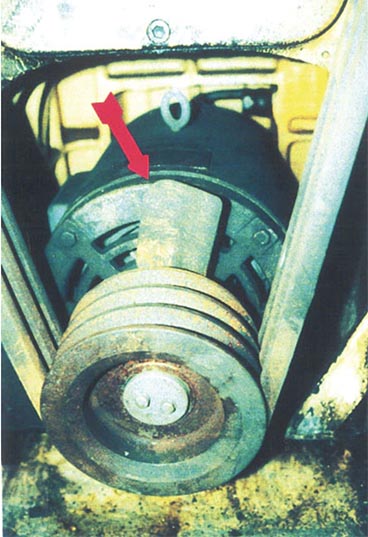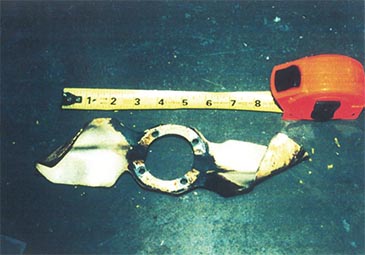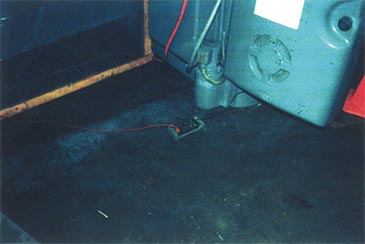Motor Accident 2
The Case Of The Machine Mutilation
March 18, 2016
The accident
To begin the troubleshooting process, the back cover of the machine was removed, exposing the motor and pulley arrangement (Photo 1). Technician #1 checked his test equipment, while Technician #2 crouched down at the rear of the machine. The machine motor was running, as was a fan blade located in front of the motor on the same shaft (Photo 2). The fan blade (indicated by a red arrow) was not easily noticed because it was spinning rapidly. In addition, its diameter was only 1 in. larger than the diameter of the motor, making it difficult to distinguish from the main unit.
When Technician #2 reached toward the motor with his right hand — in an effort to feel how hot the metal casing was — he experienced what he believed was an electric shock. Instinctively, he jerked his hand sideways. This movement caused his sleeve and wrist to become caught in the in-going nip point of the pulley and pulley belt, which severed his hand.
The aftermath
Following the accident, emergency personnel arrived on the scene in less than 10 minutes. In the meantime, clothing was wrapped around the bloody arm. The missing hand was found and wrapped in clothing in the hopes that it could be transported to the hospital and reattached. Only later did a careful check of the appendage reveal that the hand was actually missing the index finger. The victim was transported to a nearby hospital, while Technician #1 and other witnesses were interviewed.
Shortly thereafter, the vice president of the facility arrived on-site and found the finger on the floor. Because it was neatly severed (rather than torn or pulled off), this suggested what Technician #2 had initially perceived as an electric shock was, in all probability, the moment at which the fan blade (Photo 3) sliced off his finger. This hypothesis was further corroborated by the bent fan blade, which was later removed from the machine (Photo 3).



The lawsuit
We were hired by the insurance company representing the building’s owner (the machine shop and building were owned by the same person), who was one of four defendants in this case. The power company was initially listed as a defendant — the theory was that some disturbance in the power line had caused the shock. The electrical contractor, who did the initial wiring of the machine shop, was also named in the lawsuit. The fourth defendant was the manufacturer of the motor involved in the accident.
Investigation and analysis
In the course of the investigation, we visited the facility a total of four times to conduct tests and speak to witnesses. On the first site inspection, we met with Technician #1, who had been on the scene with the victim. Recalling details from the accident, he showed us the milling machine. However, due to legal reasons, we could not run the machine. He safely demonstrated how he believed the victim’s finger had been severed by the fan blade that day (Photo 4). During this process, we noted that there was no safety guard for the exposed fan blade and pulleys (once the machine’s door was opened), nor were there any warning signs posted on the machine pertaining to the fan blade.

Nevertheless, it’s important to remember that although neither man was a licensed electrician, the victim was a trained technician with more than 30 years of experience in this field while Technician #1 had more than 10 years of experience in fixing heavy machinery.
After reviewing the instruction manual, we inspected the incident milling machine and tested its electrical setup. The machine was off and receiving no electric power. With the cover off, we noticed that the milling machine motor, which was the same one that was in place at the time of the accident, was tightly bolted to the unit’s massive metal body, which was at electrical ground potential.
A layer of paint covered most of the motor, which was a 3-phase induction type, with four wires entering it. One wire was at ground potential (with zero volts across it), while the voltage across each of the three ungrounded conductors should have been nominally 220V to 240V. Since we were forbidden by attorneys in the case from powering or running the machine, we could not measure this.
To test the possibility that the victim (Technician #2) had received an electric shock when he touched the machine motor, we measured the electrical potential of the machine and motor body. To do this, we first established a reliable ground potential by locating two ground reference points in the shop near the machine. A good ground reference should have less than 25 ohms resistance between it and a “moist soil” ground (see Art. 250 of the NEC for more details). Measurements for the two reliable grounds showed a reading of almost zero ohms. Note: Our equipment could measure down to 0.05 ohms with a 0.1 ohms error. Hence, our claim of zero ohms could be in error by 0.15 ohms at most — which was still well below the 25 ohms required by the NEC.

A few days later, we were called in for a second site investigation. This time, the machine’s power was restored by an expert working for the electric utility, but the machine remained off. We measured the same 0.0006V and 0.9 ohms from the machine ground to the two reliable grounds. For legal reasons, no further testing was performed.
On our third site visit, we were allowed to turn on the machine. However, it did not start. We tested the voltage across the four wires feeding into the motor. The ground wire, whose potential mirrored that of the machine and motor housing, remained at zero (i.e., 0.006V), while the three ungrounded conductors were 239V, 2.56V, and 237V. Since the second leg of this 3-phase supply was so low, it indicated that the machine was being underpowered. An electrician, who was also part of this accident investigation, checked the power that supplied the machine. However, he found nothing wrong with it. When disconnected from the machine, all three legs were now close to 240V. We were sent home to study the problem.
After this third site visit, the attorney informed us that the electrician had allegedly found the problem. He believed that the milling machine was supposed to receive 3-phase power in a wye-configuration, but it had been hooked up in a delta arrangement.
To verify the electrician’s opinion, we called the milling machine manufacturer to find out if this was true — and if a delta arrangement would compromise the integrity of the machine. An engineer for the manufacturer confirmed that the machine should, in fact, be receiving power in the wye configuration, but that the delta configuration probably could work in some fashion, albeit inefficiently. Furthermore, it was noted that the subject machine model had not been manufactured for at least 10 years; therefore, the manufacturer’s engineer could not provide a specification sheet.
A few days later, on our fourth site visit, the electrician working the case had hooked up the machine in the wye configuration. The machine ran properly. Once again, we ran our tests. The resistance between the machine body and the two reference points remained at 0.9 ohms. The ground potential changed from 0.006V to 0.009V — an insignificant amount.
The findings
After much investigation and analysis, our inspection and electrical testing of the subject machine showed that the victim could not have received an electric shock when he touched it because even when the machine was running, the voltage in its housing was only 0.009V. This voltage was well below the level needed to cause an electric shock sensation. Furthermore, even if all the power being fed to the motor was shorted to the machine body at the time of the incident (in contrast to what was found during our testing), it would not have posed a shock hazard to the victim. This was because the motor was tightly bolted to the unit’s massive metal body, which was at electrical ground potential. Therefore, it would have absorbed any shorted power without its voltage being raised significantly. In addition, due to the fact that a layer of paint covered most of the motor surface, insulation was a factor. The paint was highly insulating (providing a resistance of more than 20,000,000 ohms). Even where the paint was chipped, the resistance was about 10,000 ohms. Only by filing and cleaning this surface could we obtain the 0.9 ohms resistance value quoted previously in this report. Therefore, it would have been highly unlikely that someone touching the motor casing at the time of the incident would have received an electric shock.
We concluded that before the accident, the fact that the machine ran hot and caused factory lights to dim was most likely caused by the machine being underpowered — possibly by being wired in a delta configuration when it was intended to be hooked up in a wye configuration. Since we were not able to review a detailed specification sheet for the subject machine, we could not be certain that the under-powering was caused by a delta/wye swap alone. But with one of the three legs of the power input not being able to deliver power, we believed this was the reason for the motor running hot, resulting in dimming of the lights. Although this wiring problem was a terribly inefficient way to deliver power, it did not pose a shock hazard to someone touching the motor housing. Thus, what the victim initially believed to be an electric shock was, in reality, the fan blade instantly severing his finger cleanly from his hand (as if it had been surgically removed). This startled him into yanking his hand back to the point where the rotating pulley and belt tore it off. In retrospect, we determined there were technically two accidents: the first involving the victim’s finger coming into contact with the rotating fan blade and the second involving the hand being severed by the pulley hardware.
In addition, the rotating fan blade was too difficult to see — both because it was spinning and the fact that it extended a mere ½ in. in radius (or 1 in. diameter) beyond the motor case. Plus, there was no safety guard to prevent someone from inadvertently contacting it when attempting to reach the motor. On the other hand, the victim was a professional, and the back of the machine had clear warnings on it about removal. Nevertheless, as an aid to the safety of the service technicians, some safety interlock and signage should have been in place. Alternatively, the fan blade could have been enclosed in a safety guard or made a half inch shorter than the motor case.
Our report in this case gave details of the ground voltage/resistance testing done during four site investigations. After it was issued, our client (the owner of the building machine shop) was removed as a defendant. The electrical contractor, who performed the wiring installation, was also cleared — as was the power company. This left the machine manufacturer as the sole defendant. The machine was built by a large vendor with “deep pockets,” but the victim in this case was a licensed professional who should have known better. He violated safety protocols he had learned and followed for decades. Unfortunately, we weren’t privy to the final outcome of this case, so we can’t divulge details as to how it was legally resolved.

